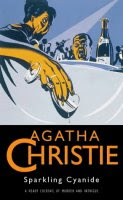One year ago, Rosemary Barton died of poisoning during her birthday celebration. The death was written off as a suicide, but now her husband George has received anonymous letters indicating that there was foul play involved. And so he plans to hold a new celebration at the same restaurant, with the same guests, but also inviting Colonel Race...
I was once again surprised to see how little Race actually does - it's turned out that in none of his appearances does he actually do much detecting. This story is probably the one that involves him most, but as it turns out he is not the one to provide the solution to the mystery.
As mentioned above, this novel is based on the Poirot story "Yellow Iris", though it's been thoroughly reworked and features a different murderer and a different motive. However, the way the murder is committed is the same in both stories - people arriving back to their table after being up on the dance floor and ending up in the wrong seat - and unfortunately I don't believe it could work.
Maybe it's just me, but I would definitely know that I wasn't sitting in the same place any more. Christie tries to explain it away by reasoning that miscellaneous objects (handbags and suchlike) have been moved around the table, but that doesn't take into account the location itself. I mean, if I was sitting with a view over another table previously and now have a different angle towards that table, I'd know that I wasn't in my original place!
This story was published in the middle of Christie's more character-driven works of the 40s and belongs firmly among them. The first half of the novel allows us to meet all the characters who were guests at the fateful birthday celebration, while the second half takes place after George Barton's 1 year anniversary dinner, ultimately leading to the conclusion and a fairly rotten murderer.
It's a good read but less of a good mystery, and so I'll rate this a 57 out of 100. Not top shelf Christie, but still worthwhile.
 |
 |
 |
| 1946 | 1951 | 1957 |
 |
 |
 |
| 1966 | 1971 | 1980 |
 |
 |
 |
| 1985 | 1990 | 1996 |
The first two Swedish editions have very similar covers, and I have to assume that the cover illustrator for the 1951 cover took a lot of inspiration from the first. Arguably that goes for the first Zebra cover from 1957 as well, but the illustrator at least included some poison being added to the glass. On the other hand, that Zebra cover is a bit too cluttered for my tastes - the title blends into the bubbles in the background.
Maybe they thought so as well, because they printed a second variant in 1966, this time with the Fontana cover. And oh look, the second Delfinserien edition from 1980 has the same cover! Though I don't mind, it's a fine cover as usual from Tom Adams. I have a copy of the 1966 version, I'm happy to say.
But before that 1980 edition, Delfinserien had already commissioned a different cover from Per Åhlin. I like his style, but the perspective on the 1971 cover is a bit wonky. But I still like it better than the book club edition from 1985. I can't understand why they had to have Rosemary's head so large in the foreground. And don't ask me what that scorpion is doing on the 1990 cover. Otherwise, depicting the fatal dinner table seems like a good choice.
Leslie Quagraine got a chance to try his hand at a cover for this title as well, but I can't say that the 1996 cover is one of his best. The face/head doesn't look good at all, and even though I like the tiny skull detail - as usual - it just doesn't come together very well. Also, where's the champagne?

No comments:
Post a Comment